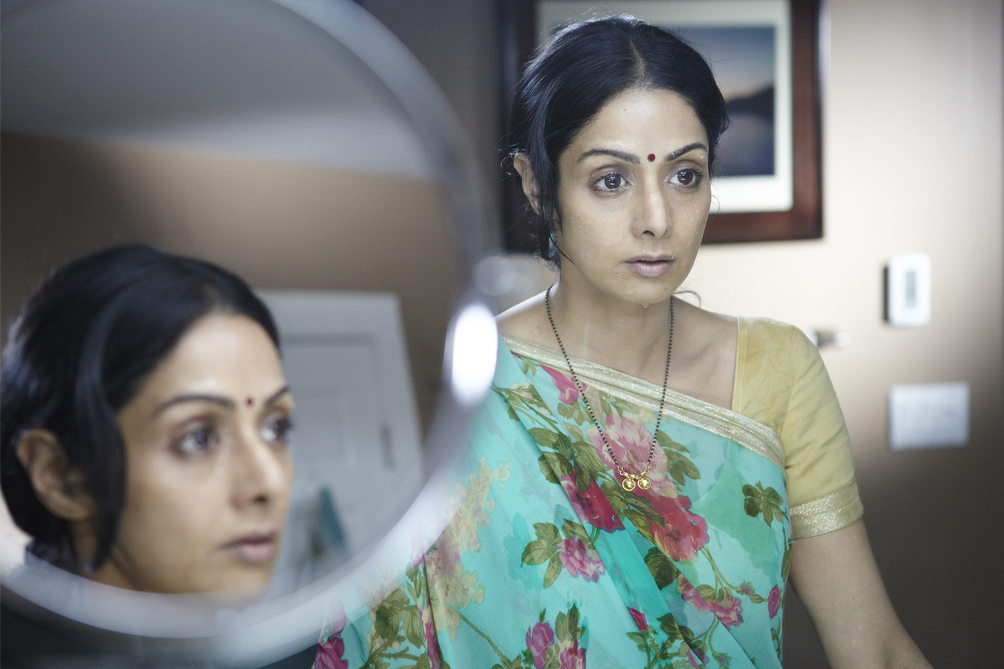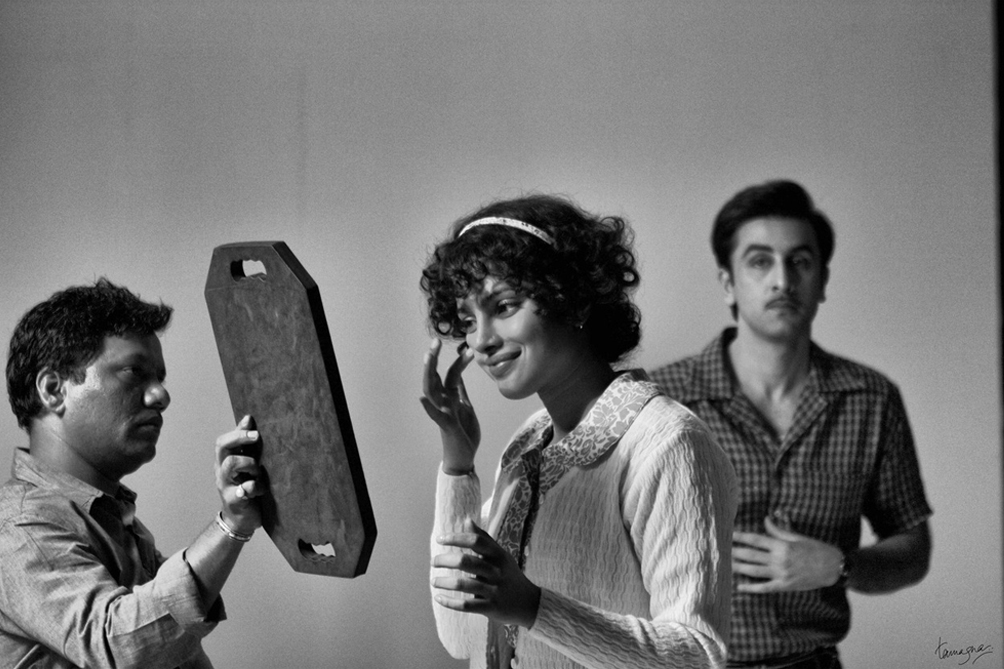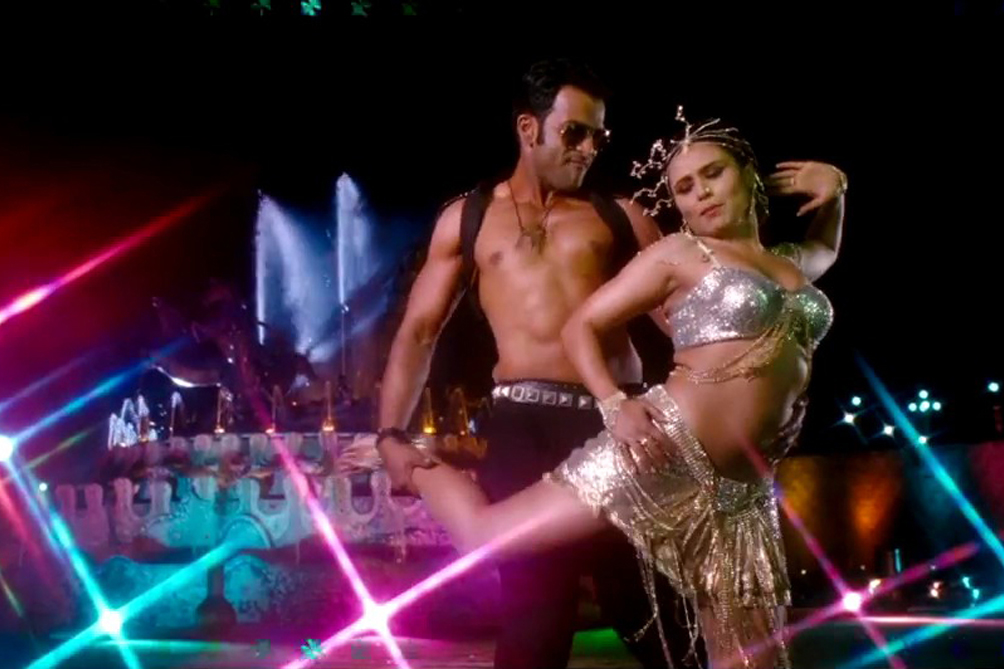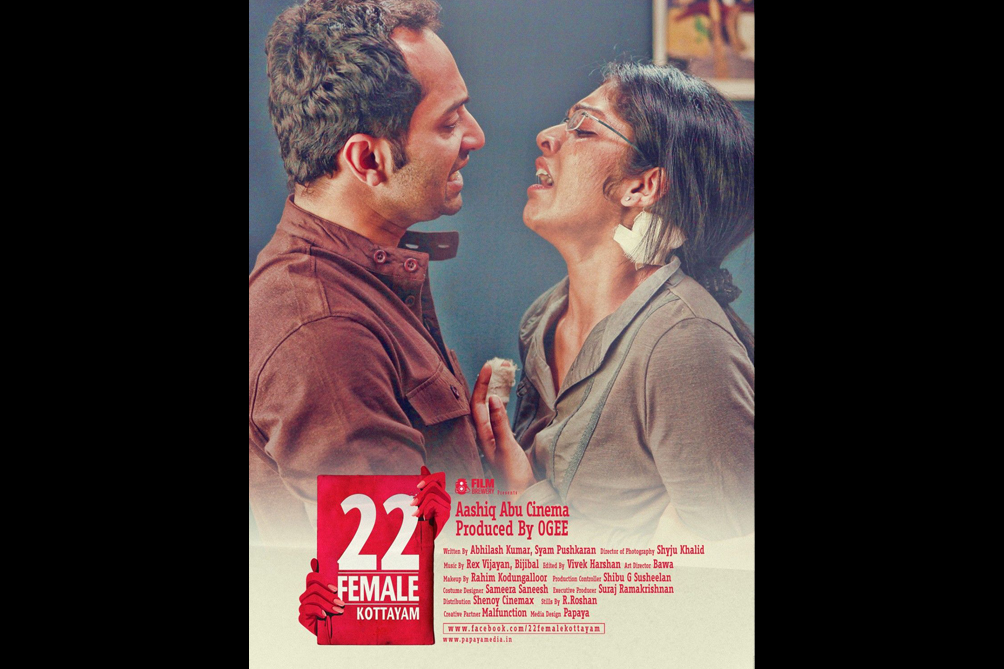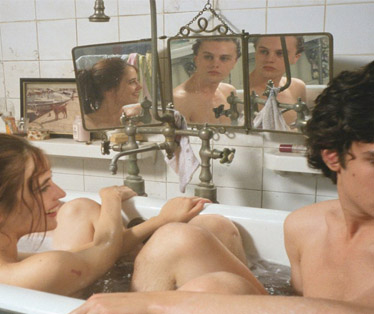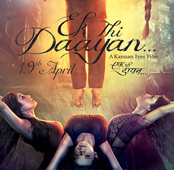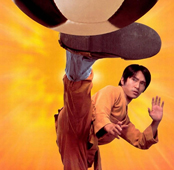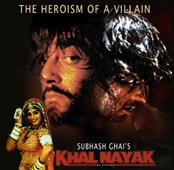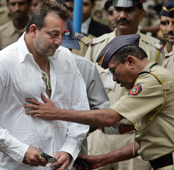-
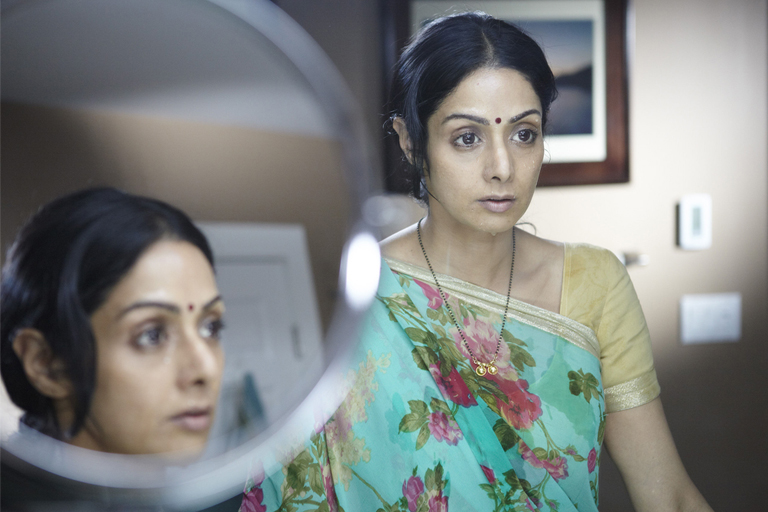 Sridevi in English Vinglish (www.englishvinglishthefilm.com)
Sridevi in English Vinglish (www.englishvinglishthefilm.com) -
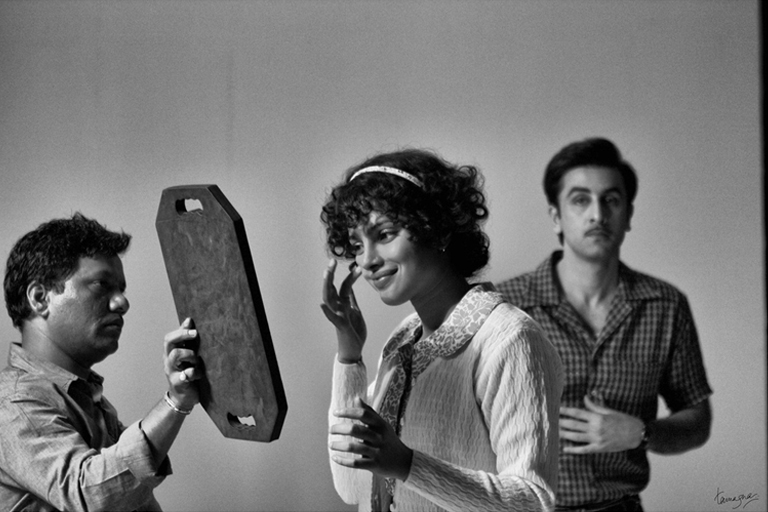 Priyanka Chopra on the sets of Barfi (c) Disney/UTV
Priyanka Chopra on the sets of Barfi (c) Disney/UTV -
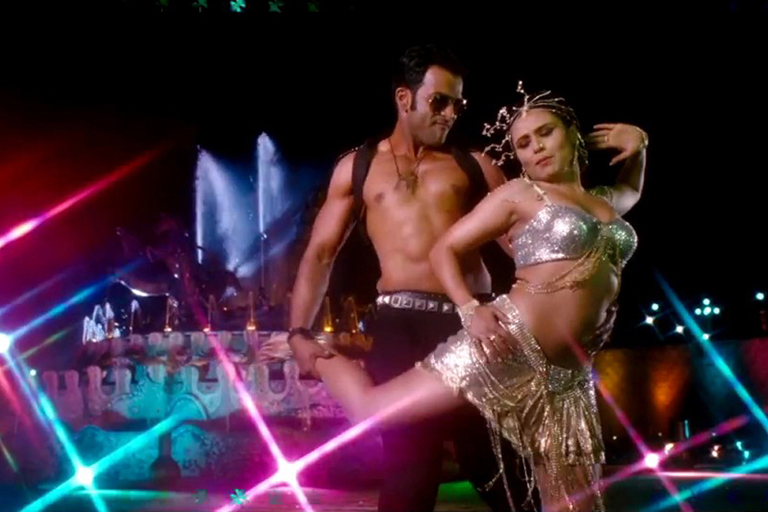 Prithviraj Sukumaran and Rani Mukherjee in Aiyyaa (c) AKFPL/Viacom18
Prithviraj Sukumaran and Rani Mukherjee in Aiyyaa (c) AKFPL/Viacom18 -
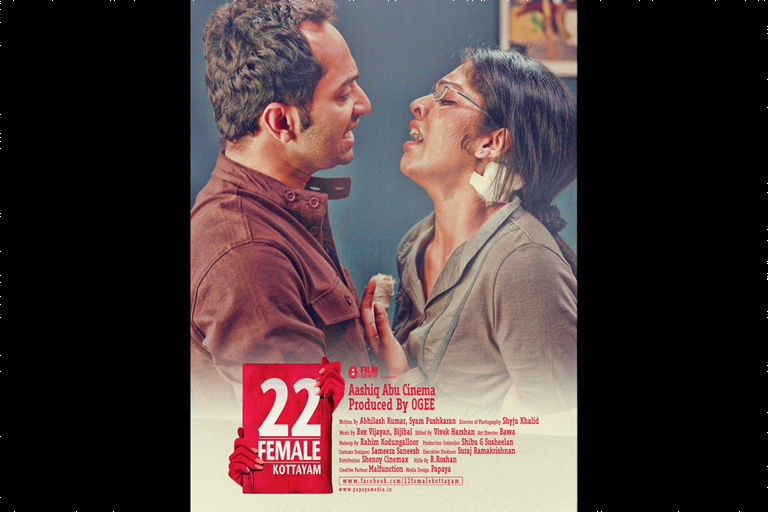 Poster of 22 Female Kottayam
Poster of 22 Female Kottayam

The Cheek of Sridevi, and Bringing Up Other Bodies
What happened to Manju of Chaalbaaz after the credits rolled and she married the stubbly suitable boy Suraj, aka Sunny Deol? Sure he loved her, certainly he was happy he married her rather than the terrified little Anju. But in a decade after they had two children did he regret not marrying someone who lubricated his social life a little more, someone whose best friend had not been a drunken taxi driver called Jaggu? What would have happened if Suraj had married the stuttering Anju, a woman replete with housewifely graces? Would he try to look away if she broke into her occasional tandav? Would it embarrass her children? Worse, would Anju suddenly claim she can’t dance at all, that she doesn’t do that sort of thing? In some ways Gauri Shinde’s English Vinglish is the dystopic sequel about the distorted afterlives of Anju, Manju and all the other girls we so admired in school.
What happens if you still one of the most expressive faces of Hindi cinema into gentility, school it into quietness, oh-let’s-just-say-it, kill it with plastic surgery? If you hadn’t already seen Sridevi this year in a terrifyingly blank-faced guest appearance in one of the early episodes of Satyamev Jayate, chances are that the first few minutes of English Vinglish would have startled you. Where in this Pune household is she hiding the feathered headgear, the chamki, the Chaplin hats, the wet blue sari, the transparent umbrella, the fake moustache, the hawa-hawai? Who foisted her with these silly children? And in an Oedipal moment, you want to slay Adil Hussain, or just chop his hand off when he reaches towards her so familiarly, so presumingly, in the conjugal bed (followed by the somewhat reassuringly retro fadeout).
It gets worse before it gets better. Because you catch her eyes. The eyes you loved, they still telegraph ‘Sridevi, Sridevi, Sridevi’ from behind the stiff kabuki mask. You don’t know these still cheeks. You don’t know this nose. Frankly, you don’t know this Scarlett O’Hara waist in the Sabyasachi saris. But there are her eyes morse-coding whole novels, like the left eye of Jean Dominique Bauby in The Diving Bell and the Butterfly.
***
The bodies of our favourite stars are as familiar to us as our lovers. We react as we do to the changes in their bodies with confusion, with proprietariness, with resistance. We exclaim, we coo, we complain. How could he? How could she? When did this… ? Why on earth that?
Contemplate the new pillowiness of Priyanka Chopra’s lips in Barfi as they unfurled, a simple red banner of cinematic autism. What will we do with these lips, you and I and Priyanka Chopra in the years ahead? Will they be a prop we wished she would be rid of? Or will we, like Henry Higgins, grow accustomed to her face. Will we miss those lips if they go?
More worryingly, what will happen as Indian moviegoers grow accustomed to being accustomed? Will we demand more crossly and anxiously that our heroes and heroines seal themselves in amber? Already we play the party game of ‘he had work done/she had work done’ as if it were an application to the Delhi Development Authority to build another room on our roof. Our party game is why Sridevi’s cheeks won’t move. And in another decade, the violence of our nostalgia, our fondness for taxidermy could well freeze the current melting-wax-malleability of Ranbir Kapoor’s face.
There were three other women with me in the lift of the South Delhi multiplex as we all sped to the Saturday 10 am show of English Vinglish – they were earnestly trading notes on the lies they had told their households to get away. The same night, when the bandh lifted in Bangalore and the single-screen theatre Rex had its first show of the day, English Vinglish went house-full. From balcony to Gandhi-class, every seat was taken, every row full of women and men having visceral reactions to the immersion experience of Sridevi. And sometimes, very rarely, our heroes insist on surprising us: despite our craven cowardice, despite themselves.
Like a feathered hat, like a sequined headdress, Sridevi was making her stillness work to tell us that we have no idea what’s happening behind the blank faces of the sweet, trembling-voiced Shashis we think we know. Kisi ke haath na aayegi ye ladki.
***
Later, I had more tempered reactions to Rani Mukherji in the Aiyyaa trailer saying, “Mujhe gore log nahi kaale log pasand hain.” But I must admit my first instinct was: vomit.
It’s one thing for SRK to ‘Enna Rascala’ or eat noodles with curd. What of my father goes? It’s quite another thing for the same idiocy to be inflicted upon Prithviraj Sukumaran, flower of Malayali youth, oiled, pecced and buffed like Razia Sultana’s Abyssinian slave (by which we mean Dharmendra, of course). The fetishising of the skin colour of Prithviraj is an easy subject of a rant (more on that later). At this point, though, the greater source of annoyance is Bollywood’s boring borrowing, the rusty razor blade of its cultural referencing. Kitschy cuteness won’t quite cut it. Not when YouTube now offers such backlists of self-confidence, ranging from the horse-riding Psy’s Gangnam Style to the golf-playing Rajnikanth and Satyaraj in Ennama Kannu from the 1986 Tamil hit Mr. Bharat.
Yes, the plunder of vintage south Indian songs was inevitable after Bollywood made its recent ghastly foray in The Dirty Picture and Om Shanti Om. Let’s not even go there. But those lyrics from Aiyyaa? ‘Dreamum wake upum critical conditionum‘? This two months after we had the sensational melange of O Womaniya (Bhojpuri-English), a full eight months after the masterful Pyarge Aagbittaite (Kannada-Urdu), or even, say, five years after the thrilling first phrase of Saroja Samaan Nikalo (Tamil-Hindi)? Vandi nirthango, Rani! To return to the dusk of Prithviraj, the pecs of Prithviraj. On the slim chance that some day Bollywood will no longer think a Shaitan is a south Bombay kid buying cough syrup and running over people with his car, it might want to turn its hungry attentions away from Prithviraj’s skin to Fahad Fazil’s penis. Or the lack thereof.
Young Malayali director Aashiq Abu’s bizarre 22 Female Kottayam was released in April, but the debates about its denouement are still alive and furious online. Here is a movie almost entirely about bodies, almost entirely about refusing to let you get accustomed (spoilers ahead). Its heroine Tessa (Rima Kallingal) is a nurse, virtuous and sweet. Most virtuous when she tells her new lover Cyril (Fahad Fazil) that she is not a virgin, and that in high school she had an affair with a married man. Tessa is raped twice by Cyril’s boss. These rapes are not fleeting plot devices. Each time she is left with bruises, fractures, needing medical attention.
Twice-raped and even more gruesomely betrayed, Tessa hatches a plan for revenge. Meanwhile, there are other bodies. The swollen pregnancy of the murderer she befriends in jail. Her roommate’s lover’s once-distasteful middle-aged body who she now sleeps with affectionately. There is even a brief tribute to cinema-makeovers when Tessa pretends to herself that a change of hairstyle will disguise her from Cyril.
The strangeness of the movie blooms into full-throttle-crazy in its last quarter. Cyril wakes up in his own bed, tied and hooked up to various tubes and catheters. Tessa has drugged and castrated him. When his rage subsides, he sardonically tells Tessa that she’ll find out eventually that a man is not just his penis– that he is still a man. Tessa replies that she’s catching a flight to Canada and is only waiting for him to heal.
And then we come to the final exchange that is still driving amateur and professional moviegoers crazy, that has already generated half a dozen academic papers.
Tessa tells Cyril that he can follow her to Canada if he wants to. As she picks up her bags and leaves, looking glamorous and oh-so-competent, Cyril says to her “You are a real woman.” Then he continues smilingly, “I will come to see you when I can. To meet you. If I miss you.” Tessa grins and leaves. Is this a return to tenderness? Is it an acknowledgement of a game well-played? Is it just the signal of a sequel? Arguing about what the hell really happened in 22FK is still entertaining viewers months later.
22FK is often tacky, sometimes embarrassingly. But its downs seem like ups when the alternative is participating in Bollywood’s waking dreamum of world conquest. This film with its mainstream stars watched by the general moviegoer presents the body as part of its plot, not as an accessory. A pretty girl and a hunky guy, a raw rape, unattractive people having sex. If the bodies were airbrushed 22FK wouldn’t be so unsettling. It would just be another Botox Bhari Maang.
The TBIP Take
OpinionOctober 2012
 By Nisha Susan
By Nisha Susan
Nisha Susan is a writer and critic based in New Delhi. She was Features Editor at Tehelka magazine and has worked for several non-profits. Her short fiction has been published by Penguin and Zubaan and she's currently working on a novel and a book on Malayali nurses. Her expectations of cinema were permanently raised from watching pulp films as a three-year-old in her grandfather's village theatre.



